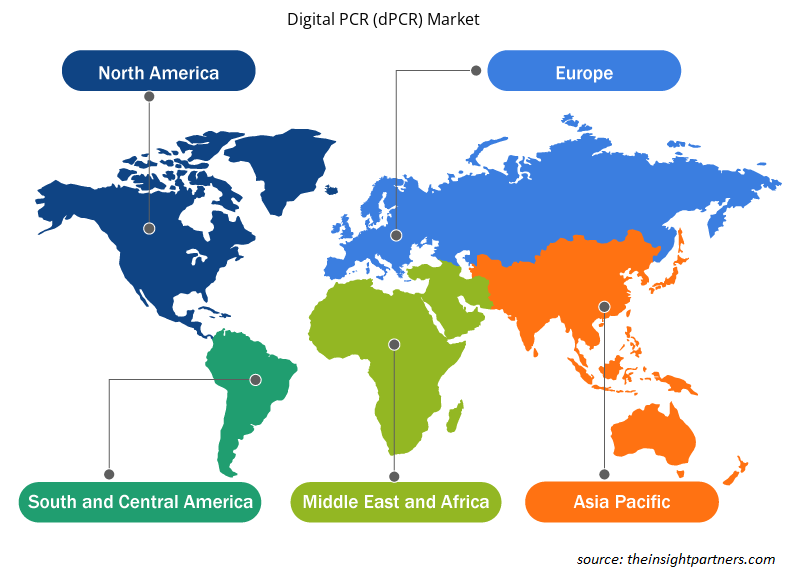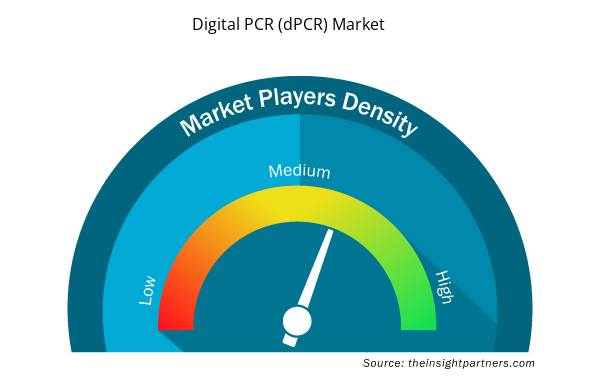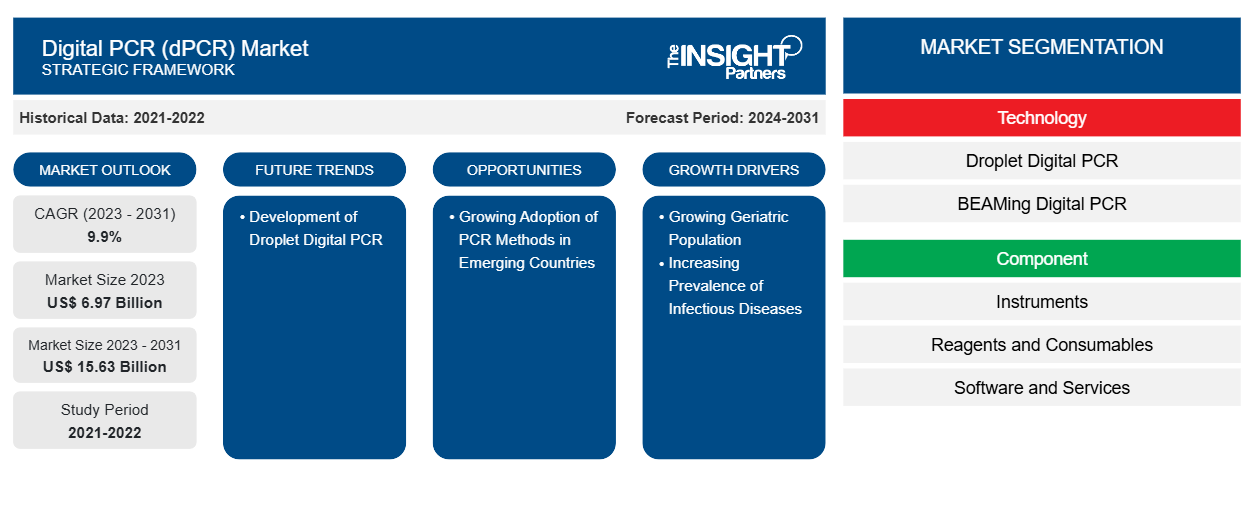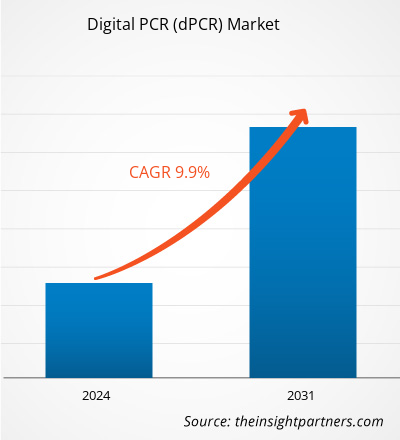Se proyecta que el tamaño del mercado de PCR digital (dPCR) alcance los 15.630 millones de dólares en 2031, desde los 6.970 millones de dólares en 2023; se estima que el mercado registrará una CAGR del 9,9 % durante 2023-2031.
La dPCR es una tecnología innovadora que ofrece cuantificación ultrasensible y absoluta de ácidos nucleicos. Es una de las técnicas más precisas, exactas y sensibles para la detección de secuencias específicas de ácidos nucleicos. Se ha convertido en una herramienta crucial y fiable para el análisis molecular. La creciente incidencia de enfermedades genéticas e infecciosas que pueden diagnosticarse y tratarse mediante técnicas de dPCR respalda el crecimiento del mercado de PCR digital (dPCR) . Las tendencias del mercado de PCR digital (dPCR) incluyen avances tecnológicos que ayudan a la cuantificación absoluta y de alta precisión de las moléculas de ADN objetivo, lo que permite una amplia gama de aplicaciones en el diagnóstico y la investigación.
Factores impulsores del crecimiento:
La síntesis de genes es la herramienta más aceptada en el campo de la tecnología del ADN recombinante. En la síntesis de genes, la expresión de proteínas recombinantes y la tecnología dPCR se utilizan tanto para fines de amplificación como de cuantificación. En 2021, Camena Bioscience, una empresa emergente de biología sintética que suministra genes a las industrias biotecnológica y farmacéutica, completó una ronda de financiación de Serie A de 10 millones de dólares liderada por Mercia. Con los fondos adicionales, la empresa planea expandir sus operaciones e impulsar sus esfuerzos de desarrollo de gSynth, su innovadora plataforma de síntesis de ADN. La plataforma tecnológica y otros recursos relacionados ayudan a la empresa a acelerar el desarrollo de la síntesis de genes.
En 2020, EVONETIX LTD, una startup de biología sintética que crea una plataforma de escritorio para la síntesis genética de alta fidelidad, rápida y escalable, anunció la finalización de su ronda de financiación de Serie B. La empresa, liderada por Foresite Capital (un nuevo inversor), recaudó 30 millones de dólares (23 millones de libras esterlinas) en esta ronda. Por lo tanto, el aumento de las inversiones de las empresas impulsa el crecimiento del mercado de síntesis genética, lo que contribuye al crecimiento del mercado de PCR digital (dPCR).
Personalice este informe según sus necesidades
Obtendrá personalización en cualquier informe, sin cargo, incluidas partes de este informe o análisis a nivel de país, paquete de datos de Excel, así como también grandes ofertas y descuentos para empresas emergentes y universidades.
- Obtenga las principales tendencias clave del mercado de este informe.Esta muestra GRATUITA incluirá análisis de datos, desde tendencias del mercado hasta estimaciones y pronósticos.
Segmentación y alcance del informe:
El análisis del mercado de PCR digital (dPCR) se ha llevado a cabo considerando los siguientes segmentos: tecnología, componente, aplicación, usuario final y geografía. Según la tecnología, el mercado se segmenta en PCR digital de gotas (ddPCR) y PCR digital BEAMing. En términos de componentes, el mercado se clasifica en instrumentos, reactivos y consumibles, y software y servicios. Según la aplicación, el mercado se clasifica en clínico, de investigación y forense. El alcance geográfico del informe de mercado de PCR digital (dPCR) cubre América del Norte (EE. UU., Canadá y México), Europa (Francia, Alemania, Reino Unido, España, Italia y el resto de Europa), Asia Pacífico (China, Japón, India, Corea del Sur, Australia y el resto de Asia Pacífico), Oriente Medio y África (Arabia Saudita, Sudáfrica, Emiratos Árabes Unidos y el resto de Oriente Medio y África) y América del Sur y Central (Brasil, Argentina y el resto de América del Sur y Central).
Análisis segmental:
El mercado de PCR digital (dPCR), por producto, se clasifica en PCR digital de gotas (ddPCR) y PCR digital BEAMing. El segmento ddPCR tuvo una participación de mercado significativa en 2023. Se prevé que registre la CAGR más alta del mercado durante 2023-2031.
Según los componentes, el mercado se clasifica en instrumentos, reactivos y consumibles, e indicaciones de software y servicios. El segmento de reactivos y consumibles tuvo una participación de mercado significativa en 2023 y se estima que registrará la CAGR más alta durante 2023-2031.
Según la aplicación, el mercado se segmenta en clínico, de investigación y forense. El segmento clínico tuvo una participación significativa en el mercado de PCR digital (dPCR) en 2023; se espera que registre la CAGR más alta durante 2023-2031.
Según el usuario final, el mercado está segmentado en hospitales y centros de diagnóstico, empresas farmacéuticas y biotecnológicas, laboratorios de investigación e institutos académicos, laboratorios forenses y organizaciones de investigación clínica. El segmento de hospitales y centros de diagnóstico tuvo una participación de mercado significativa en la PCR digital (dPCR) en 2023; se espera que registre la CAGR más alta durante 2023-2031.
Análisis regional:
En términos geográficos, el mercado de PCR digital (dPCR) está segmentado en América del Norte, Europa, Asia Pacífico, América del Sur y Central, y Oriente Medio y África. En 2023, América del Norte capturó una parte significativa del mercado. En 2023, Estados Unidos dominó el mercado en esta región. El crecimiento del mercado de PCR digital (dPCR) en América del Norte se atribuye a conferencias científicas, talleres y eventos realizados en Estados Unidos y Canadá, que ayudan a los participantes de diferentes partes del mundo a intercambiar tendencias y los últimos resultados de investigación basados en PCR. Por ejemplo, Global Engage de Global Information Incorporation llevó a cabo una cumbre de dos días en la que se presentaron las contribuciones de científicos de todo el mundo sobre las estrategias y el desarrollo de la dPCR, así como se analizaron estudios de casos que involucran la contribución de la dPCR en la atención médica. La participación activa del país también es uno de los factores impulsores que conducen al crecimiento de la región en el mercado global de PCR digital (dPCR) en la región.
Desarrollos industriales y oportunidades futuras:
El informe de mercado de PCR digital (dPCR) incluye el posicionamiento y la concentración de la empresa para evaluar el desempeño de los competidores en el mercado. Según los comunicados de prensa de la empresa, a continuación se mencionan algunas iniciativas adoptadas por los actores clave que operan en el mercado:
- En julio de 2023, Bio-Rad Laboratories, Inc. lanzó su primer ensayo de dPCR multiplexado ultrasensible: el kit de detección de mutaciones ddPLEX ESR1. Con el lanzamiento de este producto, la empresa planea ampliar la disponibilidad de su oferta de ddPCR para el mercado de la oncología, donde los ensayos de detección de mutaciones multiplexados y altamente sensibles ayudan a la investigación traslacional, la selección de terapias y el seguimiento de enfermedades.
- En junio de 2021, Bio-Rad Laboratories Inc. presentó el “Kit de cuantificación de prevalencia del SARS-CoV-2 en aguas residuales mediante ddPCR”, un instrumento sensible, rentable y preciso para detectar el SARS-CoV-2 en las aguas residuales de la comunidad.
- Los Centros para el Control y la Prevención de Enfermedades (CDC) recomiendan técnicas ddPCR para analizar aguas residuales, y la Agencia de Protección Ambiental (EPA) ha publicado la tecnología como una forma confiable de cuantificar virus en aguas residuales.
Perspectivas regionales del mercado de PCR digital (dPCR)
Los analistas de Insight Partners explicaron en detalle las tendencias y los factores regionales que influyen en el mercado de PCR digital (dPCR) durante el período de pronóstico. Esta sección también analiza los segmentos y la geografía del mercado de PCR digital (dPCR) en América del Norte, Europa, Asia Pacífico, Oriente Medio y África, y América del Sur y Central.

- Obtenga datos regionales específicos para el mercado de PCR digital (dPCR)
Alcance del informe de mercado de PCR digital (dPCR)
| Atributo del informe | Detalles |
|---|---|
| Tamaño del mercado en 2023 | 6,97 mil millones de dólares estadounidenses |
| Tamaño del mercado en 2031 | US$ 15,63 mil millones |
| CAGR global (2023 - 2031) | 9,9% |
| Datos históricos | 2021-2022 |
| Período de pronóstico | 2024-2031 |
| Segmentos cubiertos | Por tecnología
|
| Regiones y países cubiertos | América del norte
|
| Líderes del mercado y perfiles de empresas clave |
|
Densidad de actores del mercado de PCR digital (dPCR): comprensión de su impacto en la dinámica empresarial
El mercado de PCR digital (dPCR) está creciendo rápidamente, impulsado por la creciente demanda de los usuarios finales debido a factores como la evolución de las preferencias de los consumidores, los avances tecnológicos y una mayor conciencia de los beneficios del producto. A medida que aumenta la demanda, las empresas amplían sus ofertas, innovan para satisfacer las necesidades de los consumidores y aprovechan las tendencias emergentes, lo que impulsa aún más el crecimiento del mercado.
La densidad de actores del mercado se refiere a la distribución de las empresas o firmas que operan dentro de un mercado o industria en particular. Indica cuántos competidores (actores del mercado) están presentes en un espacio de mercado determinado en relación con su tamaño o valor total de mercado.
Las principales empresas que operan en el mercado de PCR digital (dPCR) son:
- Termo Fisher Scientific, Inc.
- F. Hoffmann-la Roche Ltd.
- QIAGEN
- Biografía de Akara, Inc.
- Tecnologías Agilent, Inc.
Descargo de responsabilidad : Las empresas enumeradas anteriormente no están clasificadas en ningún orden particular.

- Obtenga una descripción general de los principales actores clave del mercado de PCR digital (dPCR)
Panorama competitivo y empresas clave:
El pronóstico del mercado de PCR digital (dPCR) puede ayudar a las partes interesadas a planificar sus estrategias de crecimiento. Thermo Fisher Scientific, Inc.; F. Hoffmann-la Roche Ltd.; QIAGEN; Akara bio, Inc.; Agilent Technologies, Inc.; Biomerieux SA; Abbott Laboratories; Merck KgaA; Promega Corporation; y BD se encuentran entre los actores destacados del mercado. Estas empresas se centran en la introducción de nuevos productos de alta tecnología, avances en productos existentes y expansiones geográficas para satisfacer la creciente demanda de los consumidores en todo el mundo.
- Análisis histórico (2 años), año base, pronóstico (7 años) con CAGR
- Análisis PEST y FODA
- Tamaño del mercado Valor/volumen: global, regional, nacional
- Industria y panorama competitivo
- Conjunto de datos de Excel



Report Coverage
Revenue forecast, Company Analysis, Industry landscape, Growth factors, and Trends

Segment Covered
This text is related
to segments covered.

Regional Scope
North America, Europe, Asia Pacific, Middle East & Africa, South & Central America

Country Scope
This text is related
to country scope.
Preguntas frecuentes
dPCR is a new technique utilized for DNA amplification and quantification that uses molecular counting protocol. dPCR is usually used to distinguish the expression of alleles, track viral infection to individual bacterial cells, quantify cancer genes, and detect fetal DNA in circulating blood.
The Digital PCR (dPCR) market is expected to be valued at US$ 15.63 billion by 2031.
The global Digital PCR (dPCR) market is segmented based on technology, component, application, and end user. The Digital PCR (dPCR) market, by component, is categorized into instruments, reagents and consumables, and software and services. The reagents and consumables segment held a significant market share in 2023 and is anticipated to record the highest CAGR in the market during 2023–2031.
The factors driving the growth of the Digital PCR (dPCR) market include the rising incidence of infectious diseases and technological advancements in PCR technologies. However, the high costs of PCR systems, hampers the growth of the Digital PCR (dPCR) market.
The Digital PCR (dPCR) market was valued at US$ 6.97 billion in 2023.
The Digital PCR (dPCR) market majorly consists of the players, including Thermo Fisher Scientific, Inc.; F. Hoffmann-la Roche Ltd.; QIAGEN; Akara bio, Inc.; Agilent Technologies, Inc.; Biomerieux SA; Abbott Laboratories; Merck KgaA; Promega Corporation; and BD.
Trends and growth analysis reports related to Life Sciences : READ MORE..
The List of Companies - Digital PCR (dPCR) Market
- Thermo Fisher Scientific, Inc.
- F. Hoffmann-la Roche Ltd
- QIAGEN
- Akara bio, Inc.
- Agilent Technologies, Inc.
- Biomerieux SA
- Abbott Laboratories
- Merck KgaA
- Promega Corporation
- BD.
The Insight Partners performs research in 4 major stages: Data Collection & Secondary Research, Primary Research, Data Analysis and Data Triangulation & Final Review.
- Data Collection and Secondary Research:
As a market research and consulting firm operating from a decade, we have published and advised several client across the globe. First step for any study will start with an assessment of currently available data and insights from existing reports. Further, historical and current market information is collected from Investor Presentations, Annual Reports, SEC Filings, etc., and other information related to company’s performance and market positioning are gathered from Paid Databases (Factiva, Hoovers, and Reuters) and various other publications available in public domain.
Several associations trade associates, technical forums, institutes, societies and organization are accessed to gain technical as well as market related insights through their publications such as research papers, blogs and press releases related to the studies are referred to get cues about the market. Further, white papers, journals, magazines, and other news articles published in last 3 years are scrutinized and analyzed to understand the current market trends.
- Primary Research:
The primarily interview analysis comprise of data obtained from industry participants interview and answers to survey questions gathered by in-house primary team.
For primary research, interviews are conducted with industry experts/CEOs/Marketing Managers/VPs/Subject Matter Experts from both demand and supply side to get a 360-degree view of the market. The primary team conducts several interviews based on the complexity of the markets to understand the various market trends and dynamics which makes research more credible and precise.
A typical research interview fulfils the following functions:
- Provides first-hand information on the market size, market trends, growth trends, competitive landscape, and outlook
- Validates and strengthens in-house secondary research findings
- Develops the analysis team’s expertise and market understanding
Primary research involves email interactions and telephone interviews for each market, category, segment, and sub-segment across geographies. The participants who typically take part in such a process include, but are not limited to:
- Industry participants: VPs, business development managers, market intelligence managers and national sales managers
- Outside experts: Valuation experts, research analysts and key opinion leaders specializing in the electronics and semiconductor industry.
Below is the breakup of our primary respondents by company, designation, and region:

Once we receive the confirmation from primary research sources or primary respondents, we finalize the base year market estimation and forecast the data as per the macroeconomic and microeconomic factors assessed during data collection.
- Data Analysis:
Once data is validated through both secondary as well as primary respondents, we finalize the market estimations by hypothesis formulation and factor analysis at regional and country level.
- Macro-Economic Factor Analysis:
We analyse macroeconomic indicators such the gross domestic product (GDP), increase in the demand for goods and services across industries, technological advancement, regional economic growth, governmental policies, the influence of COVID-19, PEST analysis, and other aspects. This analysis aids in setting benchmarks for various nations/regions and approximating market splits. Additionally, the general trend of the aforementioned components aid in determining the market's development possibilities.
- Country Level Data:
Various factors that are especially aligned to the country are taken into account to determine the market size for a certain area and country, including the presence of vendors, such as headquarters and offices, the country's GDP, demand patterns, and industry growth. To comprehend the market dynamics for the nation, a number of growth variables, inhibitors, application areas, and current market trends are researched. The aforementioned elements aid in determining the country's overall market's growth potential.
- Company Profile:
The “Table of Contents” is formulated by listing and analyzing more than 25 - 30 companies operating in the market ecosystem across geographies. However, we profile only 10 companies as a standard practice in our syndicate reports. These 10 companies comprise leading, emerging, and regional players. Nonetheless, our analysis is not restricted to the 10 listed companies, we also analyze other companies present in the market to develop a holistic view and understand the prevailing trends. The “Company Profiles” section in the report covers key facts, business description, products & services, financial information, SWOT analysis, and key developments. The financial information presented is extracted from the annual reports and official documents of the publicly listed companies. Upon collecting the information for the sections of respective companies, we verify them via various primary sources and then compile the data in respective company profiles. The company level information helps us in deriving the base number as well as in forecasting the market size.
- Developing Base Number:
Aggregation of sales statistics (2020-2022) and macro-economic factor, and other secondary and primary research insights are utilized to arrive at base number and related market shares for 2022. The data gaps are identified in this step and relevant market data is analyzed, collected from paid primary interviews or databases. On finalizing the base year market size, forecasts are developed on the basis of macro-economic, industry and market growth factors and company level analysis.
- Data Triangulation and Final Review:
The market findings and base year market size calculations are validated from supply as well as demand side. Demand side validations are based on macro-economic factor analysis and benchmarks for respective regions and countries. In case of supply side validations, revenues of major companies are estimated (in case not available) based on industry benchmark, approximate number of employees, product portfolio, and primary interviews revenues are gathered. Further revenue from target product/service segment is assessed to avoid overshooting of market statistics. In case of heavy deviations between supply and demand side values, all thes steps are repeated to achieve synchronization.
We follow an iterative model, wherein we share our research findings with Subject Matter Experts (SME’s) and Key Opinion Leaders (KOLs) until consensus view of the market is not formulated – this model negates any drastic deviation in the opinions of experts. Only validated and universally acceptable research findings are quoted in our reports.
We have important check points that we use to validate our research findings – which we call – data triangulation, where we validate the information, we generate from secondary sources with primary interviews and then we re-validate with our internal data bases and Subject matter experts. This comprehensive model enables us to deliver high quality, reliable data in shortest possible time.


 Obtenga una muestra gratuita de este informe
Obtenga una muestra gratuita de este informe